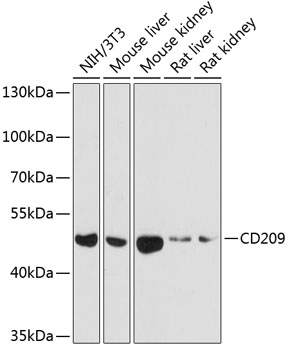CD209 Polyclonal Antibody
For reference only. Please follow the manual included in your kit for instructions.
Catalog Number
RD81865A
Product Name
CD209 Polyclonal Antibody
Catalog Number
RD81865A
Purification Method
Affinity purification
Isotype
IgG
Host
Rabbit
Background
This gene encodes a transmembrane receptor and is often referred to as DC-SIGN because of its expression on the surface of dendritic cells and macrophages. The encoded protein is involved in the innate immune system and recognizes numerous evolutionarily divergent pathogens ranging from parasites to viruses with a large impact on public health. The protein is organized into three distinct domains: an N-terminal transmembrane domain, a tandem-repeat neck domain and C-type lectin carbohydrate recognition domain. The extracellular region consisting of the C-type lectin and neck domains has a dual function as a pathogen recognition receptor and a cell adhesion receptor by binding carbohydrate ligands on the surface of microbes and endogenous cells. The neck region is important for homo-oligomerization which allows the receptor to bind multivalent ligands with high avidity. Variations in the number of 23 amino acid repeats in the neck domain of this protein are rare but have a significant impact on ligand binding ability. This gene is closely related in terms of both sequence and function to a neighboring gene (GeneID 10332; often referred to as L-SIGN). DC-SIGN and L-SIGN differ in their ligand-binding properties and distribution. Alternative splicing results in multiple variants.
Immunogen Information
Immunogen
Recombinant fusion protein of human CD209 (NP_066978.1).
Gene ID
30835
Swissprot
Q9NNX6
Synonyms
CD209CDSIGNCLEC4LDC-SIGNDC-SIGN1
Calculated MW
4 kDa/18 kDa/30-45 kDa
Observed MW
46 kDa
Applications
Reactivity
Human,Mouse,Rat
Tested Applications
WB
Conjugation
Unconjugated
Dilution
WB 1:500-1:2000
Concentration
1 mg/mL
Storage Buffer
PBS with 0.02% sodium azide, 50% glycerol, pH7.3
Storage Instructions
Store at -20°C. Avoid freeze / thaw cycles.
